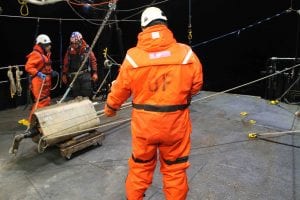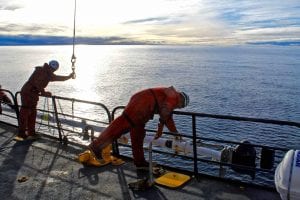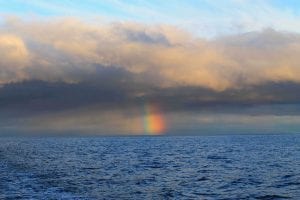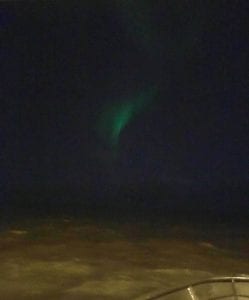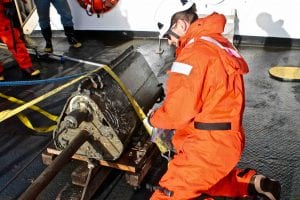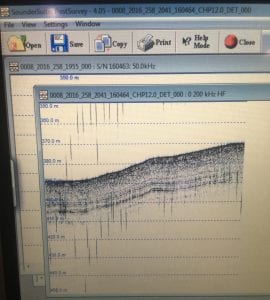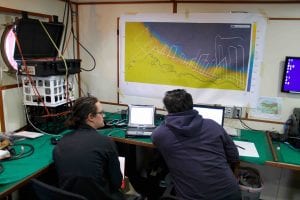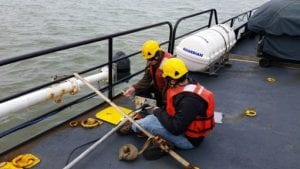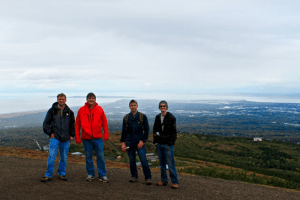Thursday September 22, 2016
Northern lights. Polar bears. Sea ice. Oh, and a little bit of data too!
By Dr. Ben Phrampus, SMU Alum
It is now day 11 aboard the Norseman II and oh boy a lot has happened since our last update! I will try to condense our epic adventure down so I can get back to data processing and interpretation.
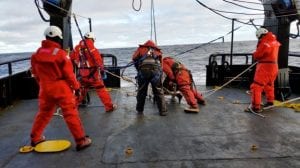
We have been collecting heat flow and chirp data for the last 10 days along four transects across the Beaufort continental margin. We have collected 116 heat flow measurements spanning over 500 km of the margin and ranging from ~200 m below sea level down to almost 2000 m. Additionally, we collected over 200 km of chirp data imaging the shallow subsurface along our heat flow transects. All the while, we have been processing data, interpreting our results, and writing up our findings. I won’t spoil the surprise here, but let’s just say we see some very interesting processes occurring offshore Alaska!
During our time at sea we had multiple equipment deployments and recoveries. It takes a lot of teamwork (and some heavy machinery) to get the 4 m long heat flow probe over the side of the ship safely, especially when there are 5 ft swells and 20 mph winds. We have an excellent crew of course and have recovered and deployed the probe 8 times with no problems. As the science crew, we get to dress up in our mustang suits and assist in the deployment. This is a great opportunity to learn about the safety procedures used on scientific vessels like the Norseman II and to learn the patience and discipline needed to work at sea. Even the students on their first cruise help in the deployment and engage in the equipment maintenance.

To process our heat flow data we use the temperature time series to establish an equilibrium temperature and determine the thermal gradient. We also use a calibrated heat pulse to determine the thermal conductivities of the sediments. Taken together we can calculate the heat flow in the marine sediments. While this does not sound particularly exciting, the information provided by this simple technique is extremely useful in understanding tectonics, fluid flow, gas hydrate dynamic, and even ocean temperature variations.

While we have collected a lot of data, we have also had a lot of fun and seen some really interesting and rare sights! At night, during the uncommon occasion that the clouds break we get to witness one of the most bizarre yet beautiful sights on this planet. The northern lights are like nothing I have seen before. These strange lights twist and turn while changing colors from green to yellow and red. They cross the sky both fading and shining is mesmerizing patterns. Sadly, it is extremely difficult to capture this beautiful performance on camera when you are riding a moving ship, but even if we could, you would still miss the twisting dance of the Aurora Borealis. All I can say is you need to witness them for yourself to really appreciate their enchanting movement.
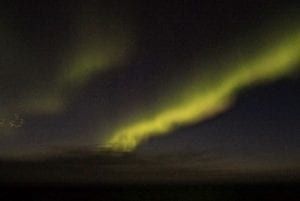
On one of our steaming trips between data collection sites, we ran into sea ice. I found this extremely interesting. I have been on multiple ships before this cruise, with one being in the Arctic Circle north of Norway, but I have still not seen sea ice till this cruise. While relaxing in the living area on the ship, we learned we were in an ice field when the ship started to divert course from the typical straight-line path. We look out the window and see a large island of ice off the starboard side of the ship! Needless to say we all ran outside (with our safety gear on of course) and began taking pictures. You can see many different colors in the ice. You see the white of the typical ice pack, the brown of Arctic sediments, the green of the algae covered ice, and the deep blue of the multiyear ice. The ice was really cool to see (pun intended), but what the ice actually brought really blew all of us away.
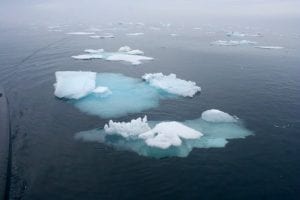

Later that day, at the beginning of our last heat flow deployment we were in the middle of an ice field getting ready to deploy the heat flow probe when we saw something we all hoped for, but that none of us imaged we would see. Off the starboard side of the ship about 0.5 miles off swimming through the ice we noticed a polar bear! But not just one polar bear, but a momma polar bear with her two cubs! They must have been curious about us because they started swimming in a straight line directly towards the ship. The science crew was amazed, but the ship crew was even more surprised! They have all seen polar bears before, having worked in the Arctic for many years, but the bears typically avoid ships and they definitely do not swim towards the ship. This momma bear was really curious though and swam towards us to within 30 yards of the ship with her cubs in tow. She and her cubs then stopped and were watching us just as intently as we were watching them. It was a strange moment while they were tying to understand us, we were just flabbergasted staring at them. Unfortunately, our time together was short as we had more science to do. So we moved on to our next waypoint as not to disturb the happy family on their ice crossing adventure.


While the data collection is over, we still have a lot of science to do. From data interpretation to paper writing and publishing, it is still a long journey to the final scientific product. Speaking of long journeys, we are currently steaming towards Nome, AK to disembark. With the addition of more ice and potentially rough weather, it appears we have a three-day journey back to port. But along the way we get to travel through the Bering Strait (maybe we can see Russia), get another opportunity to spot more rare Arctic creatures (Walrus? Narwhal? Santa Clause?), and to potentially see the Aurora one more time (please just one more time!).
More updates to come as we finish our epic Beaufort adventure!

